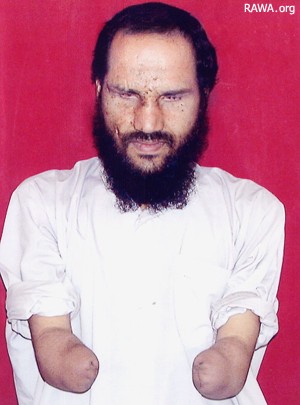KABUL - Abdul Samad was 17 when he lost his legs in a landmine explosion in Helmand Province in 1998. He wanted to commit suicide when he first realised his disability, but his family kept him alive.

Afghanistan has about 800,000 people with disabilities.
Nine years later, although he has five children, he thinks his problems have only mounted. "My children are also deprived of a happy life because of my disability," he said.
Plagued by over two decades of war, poverty and underdevelopment, Afghanistan has about 800,000 people with disabilities out of an estimated total population of 24.5 million. Many of these are also illiterate, unemployed or lack access to health services and other opportunities.
One in five households in Afghanistan has a disabled person, according to a 2005 survey conducted by Handicap International, an international non-governmental organisation campaigning on behalf of people living with disabilities.
About 36 percent of disability in the country is physical, 26 percent sensorial, 20 percent epilepsy and 10 percent mental, the survey found.
Education
Over half of Afghanistan’s disabled population is under 19, say organisations helping people with disability.
Over 72 percent of all disabled people over six have not received any education, Afghanistan’s National Disability Survey (NDS) said in 2005.
"Many hurdles impede access to education for people with disability," said Samiulhaq Sami, an adviser to the Ministry of Labour, Social Affairs, Martyrs and Disabled. "Physical, attitudinal and financial barriers mostly deny education to disabled people," he added.
Most schools and educational centres lack facilities for disabled people and access to buildings is also a major problem for those with movement problems.
Employment
Fewer than 30 percent of disabled people have jobs in Afghanistan, according to government statistics.
Apart from the disability itself, other impediments to employment are illiteracy and lack of work experience (over half of the disabled population is under 19).
In an effort to support the participation of disabled people in local and national decision-making and increase their opportunities, on 2 December the European Commission (EC) provided 1.44 million euros (about US$2.13 million) for several community-based rehabilitation projects in 11 provinces in Afghanistan.
"The EC funding will be used to improve local capacities to provide, promote and support different community-based services for disabled people," said Hanjorg Kretschmer, head of the EC delegation to Afghanistan.
Poor health services
Although Afghan officials say access to basic health services has been extended to about 80 percent of the population, money and transportation are two of the main problems faced by most disabled Afghans.
"Among the difficulties reported, disabled persons faced problems mainly regarding money for fees or medication and transportation (25.1 percent), the absence of transportation (20 percent), and far behind, the absence of medication (4 percent)," according to the NDS findings.
The government of Afghanistan pays a monthly stipend of 500 Afghanis (US$10) to war disabled, which is insufficient to meet their basic needs.
ICRC providing bulk of orthopaedic services
The International Committee of the Red Cross (ICRC) says it has donated prostheses and orthoses (artificial aids such as a brace) to over 80,000 disabled people since it launched its orthopaedic services in Afghanistan in 1988.
The ICRC is running its biggest orthopaedic programme in Afghanistan, where it annually spends about US$10 million on treatment, recovery, wheelchairs, prostheses and physiotherapy for disabled people in six orthopaedic centres around the country.
About 6,000 disabled people visit the ICRC orthopaedic centres, and the organisation distributes an average 14,000 prostheses, every year.
"We provide almost 80 percent of the orthopaedic services in Afghanistan," Alberto Cairo, head of the ICRC orthopaedic hospital in Kabul, told IRIN.
A bigger challenge for Afghan disabled people, however, is their social reintegration, which lags behind orthopaedic services, Cairo said.



